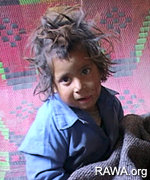KHOST - Razmi Khan, 12, was once the most outstanding student in his class, but is unable to go to school. He was badly wounded by a missile as he walked to a mosque in Nader Shah Kot District in the southeastern province of Khost on 17 November. He was taken to a local hospital where surgeons amputated his left leg to save his life.
"I cannot walk to school with one leg," Razmi told IRIN.
The missile, which also wounded another child and four adults, was fired by Afghan and international forces during a joint military exercise, Gul Qasim Khan, the governor of Nader Shah Kot District, and Col Israr Khan of the Afghan army, said.
Razmi Khan's parents said army officers and provincial officials had sympathised with them, but there had been no compensation.
As sympathies fade, Razmi Khan is gradually realising that as a disabled person he has to cope with many new difficulties: He cannot play football with his friends, ride his bicycle or go to mosque.
Right to life
In Baghlan Province where on 6 November a heavy explosion and a subsequent shootout killed 60 children and over 12 adults, many parents are grieving for their lost sons and daughters.
"My sons had committed no sin, so why did they kill them," whined Roqia, a bereaved mother of two schoolchildren killed in the incident.
In Helmand Province a widow is mourning her 15-year-old son who was hanged by Taliban insurgents for having US dollars in his pocket.
"A child's first right is the right to life. This is being denied in Afghanistan on an ever-increasing scale," the UN Children's Fund (UNICEF) said in a Child Alert report in October 2007.
Afghan Health Minister: Around 700 children under the age of five die every day. Afghanistan is facing health disaster worse than the Tsunmai.
Children "particularly vulnerable"
Afghanistan's Independent Human Rights Commission (AIHRC) estimates that over 1,400 Afghan civilians have lost their lives and hundreds of others have been wounded in armed hostilities, aerial strikes, suicide attacks and improvised explosions in the past 11 months.
Although there is no verified data on the exact number of non-combatant victims of the ongoing violence in Afghanistan, children are believed to be among the main victims, said Hangama Anwari, a commissioner on the rights of children at the AIHRC.
"Children are particularly vulnerable to the harms of war and are exposed to greater risks than others," said Anwari based on her studies of Afghan children in the conflict.
According to Afghanistan's Ministry of Education, over 237 schoolchildren have been killed in different security incidents in the past three years. However, the AIHRC says the actual number of child victims is several times higher than that.
"We do not have the capacity, resources or access to investigate and verify all the security incidents involving children all over the country," Anwari said.
Plight of children to be monitored
The AIHRC, supported by UNICEF, is working to set up a mechanism whereby the plight of Afghan children in conflict-affected areas will be monitored in accordance with UN Security Council Resolution 1612. The resolution is dedicated to the rights and protection of children in a war situation and sets out the responsibilities of parties to the conflict.
The AIHRC has repeatedly accused all sides in the armed conflict of not doing enough to protect and ensure the safety of children and other civilians during military hostilities.
Through its monitoring initiative, which will be launched in 2008, the rights watchdog will consistently remind all warring parties about their obligations to protect children during conflict, Anwari said.




